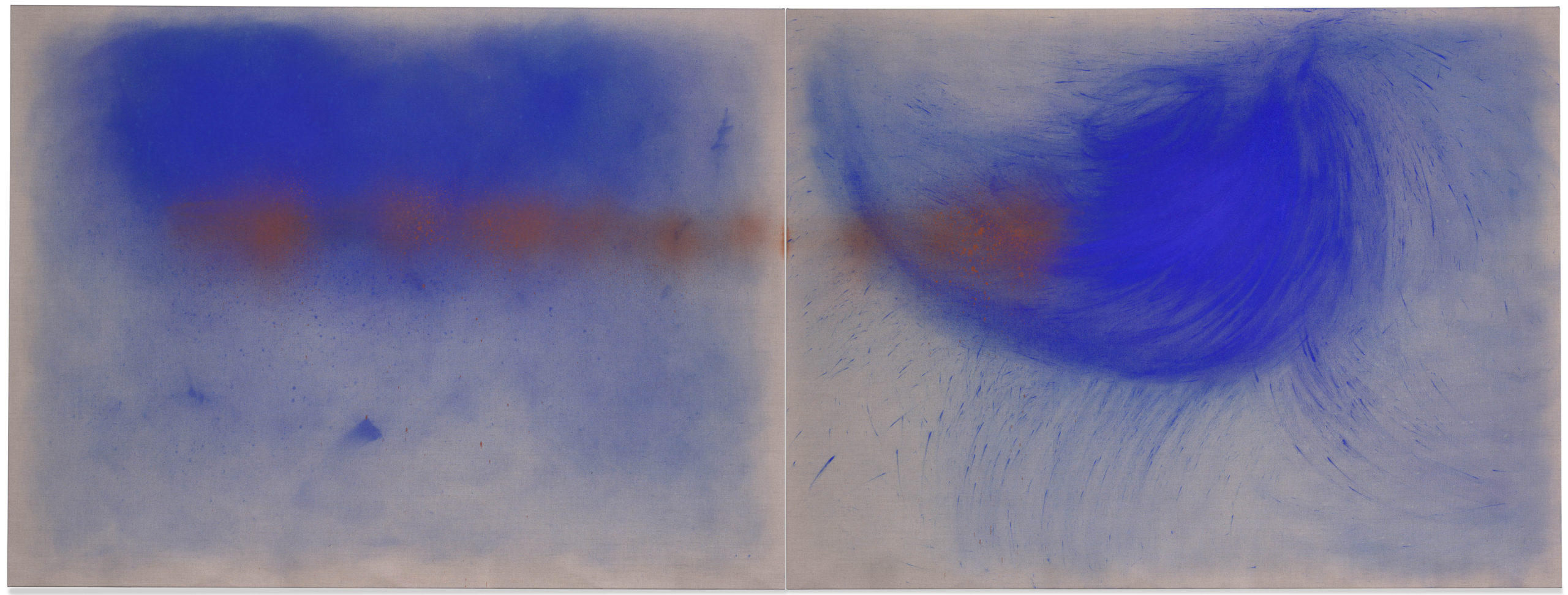 D Harding / Bidjara/Ghungalu/Garingbal peoples / Australia b.1982 / What is theirs is ours now (I do not claim to own) 2018 / Reckitt’s Blue, ochre, dry pigment and binder on linen / Diptych: 180 x 480cm (overall); 180 x 240cm (each panel) / Purchased 2019. Queensland Art Gallery | Gallery of Modern Art Foundation / Collection: Queensland Art Gallery, Gallery of Modern Art, Brisbane / © D Harding / Photograph: Natasha Harth
D Harding / Bidjara/Ghungalu/Garingbal peoples / Australia b.1982 / What is theirs is ours now (I do not claim to own) 2018 / Reckitt’s Blue, ochre, dry pigment and binder on linen / Diptych: 180 x 480cm (overall); 180 x 240cm (each panel) / Purchased 2019. Queensland Art Gallery | Gallery of Modern Art Foundation / Collection: Queensland Art Gallery, Gallery of Modern Art, Brisbane / © D Harding / Photograph: Natasha HarthCollecting new research from a range of voices, the Asia Pacific Art Papers: Contemporary Contexts, Practices, Ideas enhances awareness of artists’ practices and their distinct contexts in Asia, Australia and the Pacific. The Papers strengthen the original role of the Asia Pacific Triennial of Contemporary Art (APT), presented by the Queensland Art Gallery | Gallery of Modern Art (QAGOMA), as a forum for discussion and for deepening cultural understanding.1 The series’ objective — to generate dialogue — spans from critical essays on contemporary art to introducing visual arts of the region to a general audience. The Asia Pacific Art Papers are offered in the spirit of the extensive curatorial research into contemporary art that each APT produces, leading, over time, to a vast repertoire of knowledge and documentation within QAGOMA.
The work and ideas of Australian and, in particular, contemporary Indigenous Australian artists have been noted as central to APT as a platform for the formation of a persistent critical discourse. Former QAGOMA Curator of Indigenous Art, Bruce Johnson McLean argues that — in their distinct provocations of audiences and the institution — the works of Australian Indigenous artists in APT have offered insights into the complexities of post-invasion existence. Their work presents audiences with the unique cultures, spirituality and sensibilities of artists whose art is political in advocating for sovereignty and shifts in cultural perspectives.2 The dialogues around tradition, innovation and maintaining and elevating culture in the face of change, as well as around art’s contribution to the political landscape, have become key to the ongoing conversations each APT generates.
The Asia Pacific Art Papers augment the significance of artists’ processes of researching histories and cultures as part of the creative questioning and innovation that sit behind artworks. Brisbane-based Bidjara, Ghungalu and Garingbal artist D Harding recently noted that they honour research as an instrument of power in his practice: as a way to restore knowledge to Indigenous peoples as well as to potentially shift conventional Western systems of thinking.3 Many of the artists, curators and art writers included in the Papers similarly explore the implications arising from the challenges they face or contexts of their practice with the hope of deepening readers’ engagement. Research is the groundwork for both art practice and art writing (or dialogue) that adds to the canons of art history and the agency of audiences.
Released in three sections preceding and during ‘The 10th Asia Pacific Triennial of Contemporary Art’, the Papers comprise an accessible source of new insights into the practices and rapidly changing institutional and cultural conditions that inform the systems and worldviews of Asian, Australian and Pacific artists. The newly commissioned texts, critical reflections and conversations included here share diverse perspectives across the region and aspects of knowledge held within QAGOMA. These contributions reveal very different spaces of contemporary art compared to those included in Tradition and Change: Contemporary Art of Asia and the Pacific (1993), edited by Caroline Turner and published by the Queensland Art Gallery and University of Queensland Press on the occasion of APT1. The Papers sit within the greatly expanded field of contemporary art, evidencing the value of the ongoing publication of art research. We hope that these contributions hold relevance in shaping understanding that contains within it the potential for change.